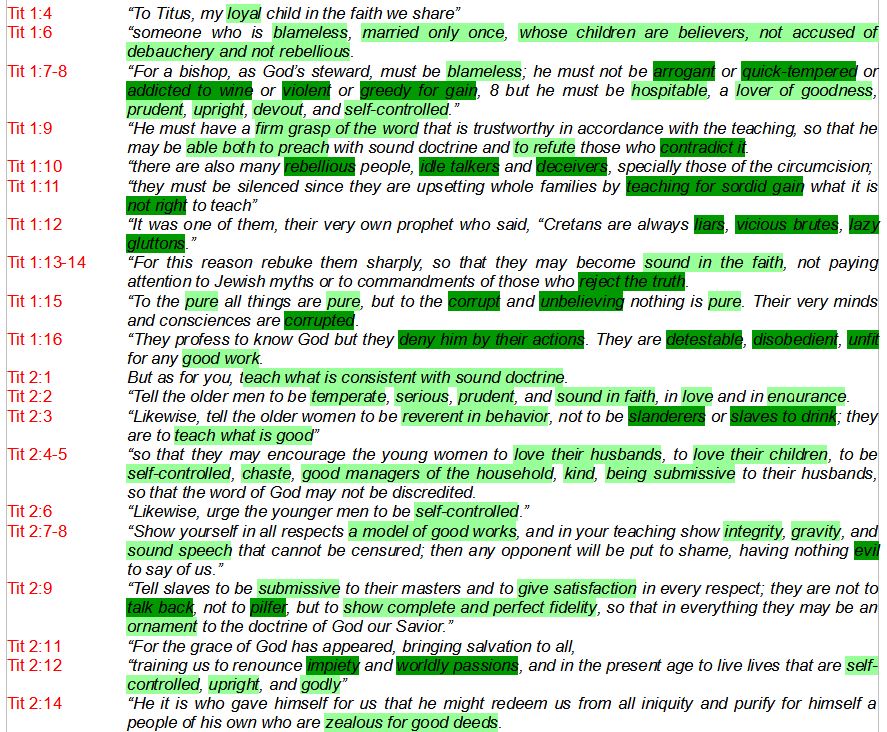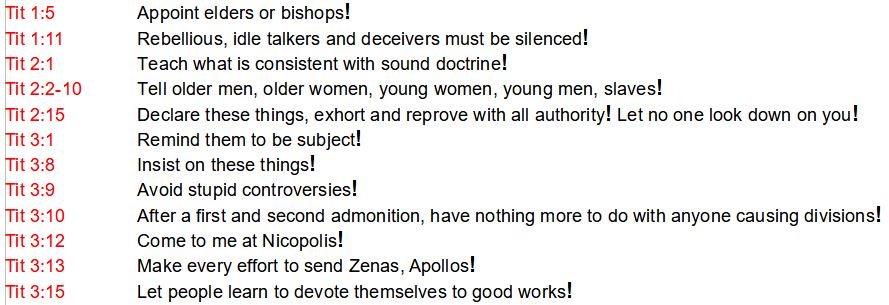TITUS 01 - Observation
Introduction to the Inductive Method Bible Study
- Observation to carefully look and observe, what is given in the text. So look! Look! Look!
- Interpretation What did this mean to the people who first got this letter? We will call them original hearers or original readers.
- Application What does this mean for me today?
- Read the letter of Titus out loud in one setting.
- It is good to read aloud for then you will see, speak and hear the text. When three senses are involved, your retention will be higher.
- The goal of this first reading is just to get a first impression of the book and pick up the main topic.
- Don’t worry about ‘not catching everything’.
- This is just meant to give you a first taste of the letter and a first exposure to its topics.
Observation
instruction
- The first step of Inductive Bible study is Observation.
- To observe means to look very carefully and notice what is given in the text.
- In order to do this well, we will ask many individual ‘Observation Questions’.
- For each Observation Question we will choose one color and go through the text coloring that one observation:
1 Observation Question: Who?
instruction
- Read through Titus again and color with one color (yellow) all words that pertain to humans (any name, description of a person, or even pronouns).
example

instruction
- God through all the verses of Titus coloring (yellow) all humans mentioned.
- Make a list.
findings
- Paul (Tit 1:1)
- Titus (Tit 1:4)
- the Cretan churches (Tit 1:5)
- Cretan church elders (Tit 1:5) and bishops (Tit 1:7),
- rebellious people, talkers, deceivers (Tit 1:10),
- circumcision preachers (Tit 1:10)
- older men (Tit 2:2)
- older women (Tit 2:3),
- young women, husbands and children (Tit 2:4),
- young men (Tit 2:6)
- slaves (Tit 2:9)
- rulers and authorities (Tit 3:1)
- Artemas (Tit 3:12)
- Tychicus (Tit 3:12)
- Zenas the lawyer (Tit 3:13)
- Apollos (Tit 3:13).
instruction
- Think about the following questions:
- Who is the author of this letter? How does he describe himself in the beginning?
- To whom is this letter addressed? How is he described?
- Who else is with the author? Whom may the author send?
- Who will shortly pass through?
- The apostle Paul writes this letter. He calls himself a servant of God and an apostle of Jesus Christ
- The letter is addressed to Titus, whom Paul calls ‘my loyal child in the faith’.
- Artemas and Tychicus are with Paul. Paul is thinking to send them shortly to replace Titus, so Titus can re-join Paul in Nicopolis.
- Paul instructs Titus to help Zenas the lawyer and Apollos who will pass through. Most likely these two people carried the letter to Titus we are reading now.
The following picture presents itself:

Artemas, Tychicus, Paul Zenas, Apollos Cretan churches Titus Jews Cretan population
2 Observation Question: Where?
Instruction
- Read through Titus again and color (blue) any geographical location, city, area, country or place that may men mentioned.
- Mostly this will be geographical uses, but it can also include metaphorical uses.
example
- Go through all the verses of Philemon and color (blue) any geographical location.
findings
- The Where Question only yields two locations: Titus is in Crete, where Paul left him behind to finish up some important work with the newly planted churches there.
- Paul is in Nicopolis (or will shortly go there) and requests Titus to meet him there, once Paul sends Artemas or Tychicus as his replacement.
3 Observation Question: When?
instruction
- Read through Titus again and color (light blue) any word that describes time.
- This could be a date, a duration, a word like “when”, a relative time indication “later”, or anything of that sort.
example
findings

4A Observation Question: Repeated themes
- You probably noticed that in Titus we find a lot of descriptions of character and behavior: What character and behavior leaders should have, old men, old women, young women, young men, slaves and Titus himself should have.
- So read through Titus again and color any good character, attitude or action with light green and every bad character, attitude or action with dark green.
- Notice how much Paul has to say about this, how highly repeated these theme is all throughout the letter.
example

findings


- Clearly the themes of good and bad character, attitude and actions is the overarching theme of Titus.
- Paul applies this with great importance to the different groups of people mentioned.
4 B Observation Question: Repeated Theme (again)
- Besides the big theme of good and bad character, there are some other repeated themes in Titus.
- Color any words that talk about preaching, teaching or speaking in pink.
example
findings

4 C Observation Question: Repeated Theme (again)
- Color any words that talk about truth, right doctrine or soundness of faith in light purple.
- Color any words that talk about lies, deception or wrong teaching in dark purple.
example

findings

5 Observation Question: Contrasts?
- Color any words that express a contrast between two things, like “but”, “rather”, “or” with red color.
- Also watch out for big contrasts running through entire passages.
example
findings


6 Observation Question: Connectives?
- Color brown any words that express a reason or intention.
- Look for words like “for this reason”, “for”, “therefore”, “so that”.
example
findings

- The most important connective of the letter is a “for” in Tit 2:11.
- It links the long passages about good and bad characteristics > to the key passage of Tit 2:11-14:
7 Observation Question: Commands?
- Look for any direct commands that Paul gives Titus.
- Mark them with a big exclamation mark.
example
findings

- Many more observations could be made in the Titus text, but we will leave it at this for now.
List of Observation Questions
- For different Bible books different Observation questions may yield most results.
- Below is given a more comprehensive list of Observation Questions, the more common observations listed first, and less common ones towards the end.
1 Who?
Look for: names of people, churches, groups, classes, tribes, nations, including pronouns, etc.
Ask yourself: who is speaking (writing)? To whom is this said (written)? Who else is mentioned?
2 When?
Look for: time elements like “before”, “after”, “now”, “when”, “at that time” … note verb tenses: past/present/future?
3 Where?
Look for: mentioned places, cities, areas, countries, any geographical terms etc.
Ask yourself: where is this written from (where is the author)? Where are the readers? What other places are mentioned? Find them on a map! What country or region are they in? What is their political, economic, religious situation?
4 What?
Ask yourself: what topics are mentioned? What happened? Which issues does the author give most importance to?
5 Repeated Words? Repeated Themes?
Ask yourself: are there repeated words? Repeated themes? What topics / ideas / concepts does the author repeat? Repetition means importance. What is the main theme? The key idea? The key word?
6 Contrasts? not ……. but …….
Look for: words expressing contrast, like “but”, “even”, “rather”, “though”, “nevertheless”, etc.
Ask yourself: what concepts, characters, events, attitudes are contrasted? What is the difference? What different consequences do the contrasted concepts have?
7 Comparisons? ….… , likewise …….
Look for: words expressing comparison, like “like”, “as”, “so”, “also” … Look for broader comparisons of concepts, ideas, characters, events, attitudes. What is compared? Which characteristics are emphasized?
8 Conditional Statements? if ….… then …….
Look for: words expressing conditions, like “if”, “then”, “if so”.
Ask yourself: what is the condition expressed? If the condition is fulfilled, what will be the result? What if not?
9 Connectives? Reasons? Results? because ….… for …….. ……. so that …….
Look for: words connecting concepts, like, “for that reason”, “therefore”, “that’s why, “yet”, “however”, “so then”, “in order that”, “nevertheless”, etc. … What are the causes? the reasons? the consequences?
10 Summary Statements? Conclusions?
Look for: words expressing summary statements or conclusions like “finally”, “therefore”, “so then”, “last of all”, etc.
11 Atmosphere? Emotion? Mood?
What feelings, atmosphere or moods are expressed? How is the author feeling? Upon hearing this, how will the audience feel?
12 Emphatic Statements
Look for: emphatic words expressing importance like “truly”, “behold”, “I tell you”, “I do not lie”, etc. … for strong statements, feelings, expressions revealing intensity. What is stressed? Why is this stressed?
13 Figures of speech? … see separate handout
14 Structure? Style? Composition? … see separate handout
15 Literary form?
Ask yourself: what type of literature is this book / passage? Is this text prose or poetry? Is it a historical narrative, a gospel, an apocalyptic writing, an epistle, a parable, law or prophecy?
16 Commands? Advice? Promises? Warnings?
17 Questions? Rhetoric Questions?
18 Lists? Progression?
Are there lists? Is there sequence or progression in the lists or in the concepts presented? Is there a climax of emotions? Does the author go from question to answer? From principle to example? From general to specific? problem to solution?
19 Logic of the Argument? What logic does the author use to argue / prove his point?
20 Illustrations? from Scripture? Every day life? Personal Experience? What is the illustration showing?
21 Quotations? from the OT? From where? What is the context of the quote?
22 Beginning? End? how does the author begin or end the book or passage? > important
Through observing the letter of Titus carefully we have done the preparation work to start understanding the story behind this letter. See ‘Titus 02 – Reconstructing the Historical Background‘.